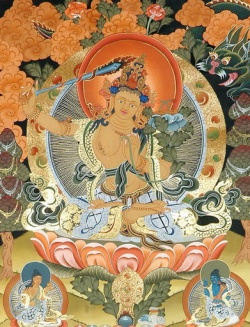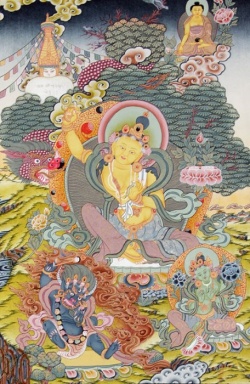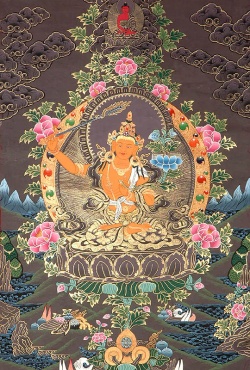Arapachana Manjushri
Manjushri is a very important 'general' Tantric meditation in the Sakya Tradition. Manjushri was important for the Five Holy Superiors of the Sakya School - the five early founders (jetsun gongma nga). He was especially important for both Sachen Kunga Nyingpo and Sakya Pandita. Both of these teachers had visions of Manjushri. Sachen heard the profound Mind Training teaching called the Separation from the Four Attachments directly from Manjushri during a six month Arapachana retreat. Sakya Pandita was even regarded as an early Tibetan emanation of Manjushri, while Sapan himself considered his own teacher, Dragpa Gyaltsen, to be Manjushri. Sapan was later to be included as the first of the Three Manjushris of Tibet along with Longchenpa Drime Ozer and Je Tsongkapa Lobsang Dragpa.
Sakya Pandita wrote a four line praise to Dragpa Gyaltsen addressing him as Manjunatha - the Lord Manjushri. However, this praise was not used or directed towards Dragpa Gyaltsen by Sakya Pandita's students but rather directed to Sakya Pandita himself who had become even more famous as a Manjushri emanation. Even today in the Sakya School this is the main praise/prayer addressed to Sapan.
"With wide eyes perceiving all things,
And compassionately achieving the good of all beings;
Having power performing acts beyond thought.
Guru Manjunata, to your feet I bow my head."
(Written by Sakya Pandita).
Padmasambhava made predictions about the rise of the Sakya Tradition and the holy location of the large patch of white earth at the place known as 'sakya.' Later, Jowo Atisha also made predictions when seeing the famous 'sakya' location and elaborated by saying that in the future there would be an emanation of Avalokiteshvara, Vajrapani and many Manjushri emanations arising from this geographic location. In Tibet the Sakya School also became known as the Manjushri Tradition. Generally, all male members of the Khon family, the hereditary leaders of the Sakya School, are each regarded as Manjushri emanations.
The three main Manjushri practices in Sakya are the
(1) Arapachana (orange or white),
(2) White (Sita) and
(3) Black (Krishna) Manjushris.
The function of the first two Manjushris is in the generation of knowledge, memory and ultimately the two forms of wisdom, prajna (sherab) and jnana (yeshe). Black Manjushri, included in the Thirteen Golden Dharmas, is for removing serious obstacles, hindrances, sickness and disease not curable or alleviated through other means.
The Arapachana form of Manjushri has a small number of different variations along with an orange version and a white version. The white form appears to be the original colour for Arapachana. It is not clear when or why the orange form developed and became the more popular form of the deity. There is the practice of the single deity and then there is the Mandala of Five Deities - Manjushri at the center surrounded by four accompanying figures. Even though Arapachana is classified as both a Kriya and Charya Tantra practice there is early evidence from the Bari Gyatsa of Bari Lotsawa Rinchen Drag that there were Perfection Stage (dzog rim) practices used to accompany the Generation Stage (kye rim) Deity Yoga. Perfection Stage techniques were generally a unique practice and characteristic of the Anuttaryoga Classification of Buddhist Tantra. The Sakya Tradition classifies the Manjushri Root Tantra, Manjushri Mulakalpa, as a Charya Tantra. (See a short essay on Tantra Classification).
The significant physical characteristics of Arapachana are the blue sword of wisdom held upraised in the right hand and the Prajnaparamita supported on an utpala blossom held in the left hand. Some forms of Arapachana describe him with the two hands in the Dharma Teaching gesture at the heart while holding the stems of two blue utpala flowers supporting the wisdom sword and Prajnaparamita book. The blue utpala flower is not a lotus. It is thought by some Western experts to be a blue lily flower.
Older archaic forms of Manjushri, depicted in painting and sculpture, place the Prajnaparamita text held to the heart in the left hand. A good example of the archaic form is the sculpture belonging to the late Dezhung Rinpoche Tenpai Nyima, previously belonging to Ngagwang Legpa Rinpoche. This form is also most often seen in early Indian, Kashmiri and Tibetan sculpture. Since the 15th or 16th centuries this variation is rarely described in the liturgical or practice manuals. See a brief explanation of the iconographic features of Arapachana. However, the most common and iconic form of Manjushri is when he is depicted holding the wisdom sword upraised to the sky, ready to cleave, symbolically severing the roots of ignorance. This is the form of the deity that is commonly practiced by the teachers of the past and the students and practitioners of today. The most special and profound practice is called the Sakya Uncommon Orange Arapachana Manjushri.
My favorite image of the deity which was also the form I was first introduced to many years ago was published by the London Buddhist Society (shown above). I am not sure who owns the actual painting, possibly the Society or perhaps the V & A Museum in London. The image here is a scan from the old folding note card. I believe what is well depicted here is the most important characteristic of the Arapachana form. That characteristic is the subtle right twist in the body created from the raising of the right arm holding the sword of wisdom. When this twist which occurs naturally is not depicted then the result is a very stiff and unnatural looking form (try it yourself while looking in the mirror). A big part of the charm of Arapachana is this youthful dexterity and suppleness described as a characteristic of the Indian deva and devi (gods and goddesses) forms found in classical Indian literature - a basis for Buddhist Tantric texts. An important epithet for Manjushri is kumara, meaning youthful, Kumara Manjushri, or Kumarabhuta Arapachana Manjushri.


